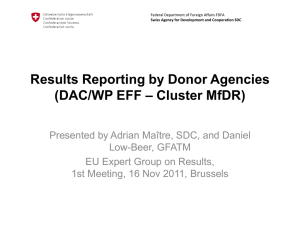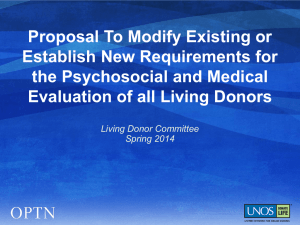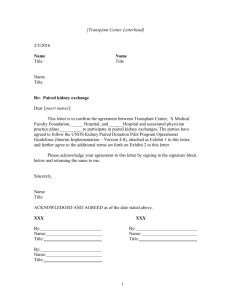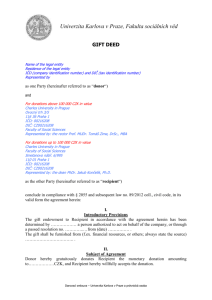inaf100_gonzalez
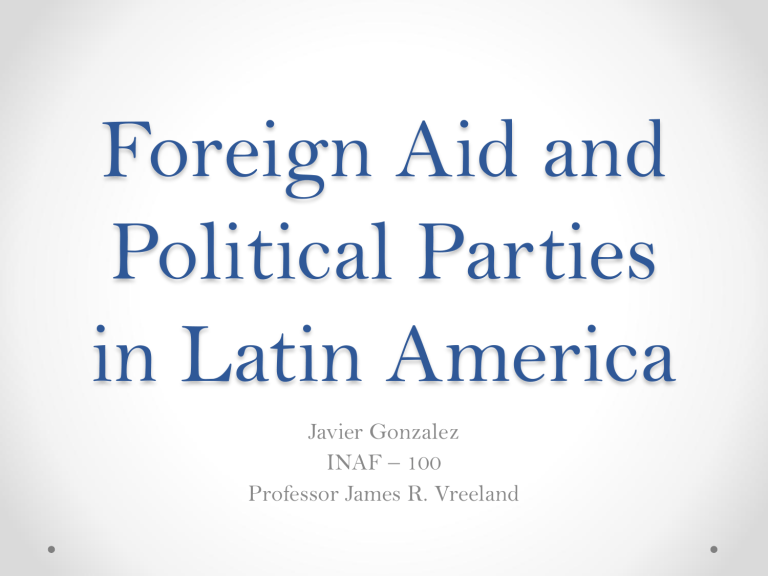
Foreign Aid and
Political Parties in Latin America
Javier Gonzalez
INAF – 100
Professor James R. Vreeland
What is the question?
• Political parties in: o Latin America o Donor countries o Right-wing/Left-wing
• Influence on foreign aid o Both observed
• Does the party of the executive power in recipient countries affect the amount of foreign aid that is received by the country?
o Does the party of the executive power in donor countries also have an effect?
Introduction
• Politics o The Right and the Left
• Donor
• Recipient o Rise of the Left in LA
• Executive heads
• Foreign Aid o 23 OECD-member donors o 17 LA countries
Background
• Democratization o Reagan administration
• Economic growth in LA o Exponential in the last decade o Poverty levels
• Reforms in LA o Led by the Left o Economic
• Leadership
Hypothesis
• Donor nations do take political positions of recipients’ executive head into consideration; therefore, they tend to provide more aid to countries that share similar political ideologies, and less to those that do not.
• Donor interest o Political/Economic o Aid o Hegemony
Methods of Observation
• Analyze o Party in power
• Right-wing or Left-wing?
• Employ o OECD
• Foreign aid o WB Database of Political Institutions
• Right or Left?
o World dataBank
• GDP per capita
• GDP annual growth
• Conclude o Observe
• Correlations o Fallacies
• Error
Observations
• Donor countries (23) o OECD members
• Recipient countries (17) o North and South America
Australia
Austria
Belgium
Canada
Denmark
Finland
France
Germany
Greece
Ireland
Italy
Japan
Korea
Luxembourg
Netherlands
New Zealand
Norway
Portugal
Spain
Sweden
Switzerland
UK
USA
Argentina
Bolivia
Brazil
Chile
Colombia
Costa Rica
Ecuador
El Salvador
Guatemala
Honduras
Mexico
Nicaragua
Panama
Paraguay
Peru
Uruguay
Venezuela
Observations
• 1960-2010 and 1990-2010
• Why 1990-2010?
o Political tendencies o Present political preferences
• 3 Categories: o Leans Right or (1) o Left (3), o Or NP/Centrist (2)
• Donor ex.
o Leans Right :
• Japan o Leans Left :
• Sweden o NP/Centrist:
• Finland
• Recipient ex.
o Leans Right:
• Colombia o Leans Left:
• Brazil o NP/Centrist:
• Mexico
• Also observed:
o From 1960-2010 o GDP per capita o Annual GDP growth
Observations
}
Recipient countries
• Why?
o Principal purpose for FA o Validity
Findings
• Regressions o Right-wing donors
• Not statistically significant o p-value of 0.62
o > .05
o Left-wing donors
• Not statistically significant o p-value of 0.85
o > .05
o NP donors
• Not statistically significant o p-value of 0.94
o > 0.05
0 2000 4000 6000 gdp_per_capita
Findings
8000 10000
• Regressions o All donors (both Left and Right)
• Not statistically significant o p-value of 0.87
o > 0.05
o All donors & GDP per capita
• Statistically significant o p-value of 0.00
o < 0.05
o All donors & annual GDP growth
• Not statistically significant o p-value of 0.13
o > 0.05
• GDP and Foreign Aid o Correlation o More poverty = more aid o Validates claims
• Annual GDP o No correlation
Conclusions
• Parties and Foreign Aid o No correlation o Right, Left, nor NP
• No political interest apparent
• Donor nations o If any political interest, poverty is still prioritized o Question of hegemony
• Recipient nations o Party has no effect
• Finally, o Social misconceptions o Hypothesis not proved o Poverty and foreign aid
Conclusions
• The political ideology of the recipient’s executive head seems to have no effect on the amount of foreign aid received
• Room for error: o Overlooked observations?
• Time period
• Human rights o El Salvador o Venezuela
• Military assistance o Anti-guerrilla/anti-narcotics
• Brazil, Colombia, Mexico
Image sources, in order: http://3.bp.blogspot.com/-4qmNSMIHiyA/T32eArLad-I/AAAAAAAAAvo/amXSz8SM_Jg/s1600/Latin-America-Map.jpg
http://nimg.sulekha.com/others/original700/cristina-kirchner-luiz-inacio-lula-da-silva-dilma-rousseff-2011-7-29-18-41-8.jpg
http://cryptome.org/info/obama-protect42/pict26.jpg
http://www.iamericas.org/images/stories/poverty_latin.jpg
http://graphics8.nytimes.com/images/2009/01/26/timestopics/bolivia_395.jpg



